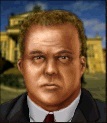Cassini
Posts: 26
Joined: 11/30/2021
Status: offline

|
Dupuy does quantify the effect of 'extreme cold' on an attacker's combat capability (10% reduction compared to no reduction for a defender), but he doesn't define what qualifies as 'extreme cold'. His data base of battles was a bit thin on battles in extreme cold conditions (most of his battle set were battles in Italy and summer battles in Europe - WWII - with a few other battles in the Middle East). I think the following would adequately account for the net cold temperature effect upon a unit.
In temperature conditions of -10 C to -25 C, all units have their AP reduced by 10% and an attacking unit also has it readiness reduced by 10%. In temperature conditions of -26 C or lower, all units have their AP reduced by 20% and attacking units have their readiness reduced by 20% while all other units have their readiness reduced by 10%. Not much of a modifier (given all the others which are in play), but here it is.
There is a somewhat greater effect on airpower due to overcast (then becoming more significant with precipitation then overwhelming with heavy precipitation), but given the VERY peripheral use of air power (and the lack of defined cloud cover), I think this can safely be ignored.
And to Mark... I was a subscriber to the long defunct TEM going back to the late 80's along with the ETO fanzine put out by Bill Stone. I am VERY familiar with all the drama that surrounded that series after Winston Hamilton's death in March 2001 - and actually took part in a semi-abortive effort to develop a system that would bring the mechanics of that old system up to date. My role was that of an Operational Researcher, and I completely disassembled Dupuy's 1979 and 1990 works (along with data put out by the Dupuy Institute between 1995 and 2005), to create a methodology of quantifying ground and air weapons and their effect (and not the crap that Europa used), which created credible, historically consistent combat resolutions (CRTs based on reality and not that piece of junk that Astell used). This included the development of an air system that could predict actual number of bomb hits upon a target based upon bombing altitude, AA fire present and target size. This was done with the determination of base CEP values for differing bombing altitudes and methodologies (dive bombing, level bombing and the compromise between the two), modified by degree of cloud cover, to produce results which mirrored actual bombing data presented by the Strategic Bombing Survey. This was done for both day and night bombing, and the effect of radio navigation and radar bombing through overcast conditions was quantified.
The effects of AAA were quantified (replicated historical results within 10%), the PhD dissertation of Westermann was critical in developing this model. The effects of CAS were quantified and integrated into the highly modified QJM model of Dupuy, the PhD dissertation of Gooderson (Air Power at the Battlefront - available online in PDF) was most useful in this endeavor.
In addition, an air combat model was created and perfected, which was able to replicate historical results to within 10% of airframes lost. This was initially inspired by what was the 'Dupuy Air Combat Methodology' - a nonpublished work which was more ideas than actual model - to create a methodology of evaluating aircraft for both their offensive and defensive potential in aerial combat. This took into account the variations in armament (Williams and Gustin's work in this field was INVALUABLE), engine power/thrust, number of engines, type of engine (radials are more resistant to damage), fuel storage (presence of self sealing tanks), presence of fuel tank inerting, mass of empty airframe, presence of armor, presence of defensive armament, roll rate of aircraft (roll rate was of defensive benefit, not offensive), wing area, maximum level speed, presence of all round visibility features (rear gunner or 'bubble canopy'), presence of radio transmitter and receiver (many early war aircraft had no radio or a receiver only - reduces combat effectiveness in a quantifiable manner), presence of supercharger and what its critical altitude was (combat was normed to altitude bands - aircraft without superchargers or single stage superchargers were at a measurable disadvantage at altitudes above 15,000 feet, and even ammunition load for weapons carried (a 20mm cannon with 60 rounds of ammo is not quite as effective in an operational level assessment of combat as an aircraft carrying 100 rounds in its 20 mm cannon). Finally the effect of gyroscopic gunsights were quantified along with the effect of radar ranging gunsights (introduced in time for Korea - data for Korean War combats was used to verify this). Again, the work put out by Anthony Williams and Emmanuel Gustin in 2003 was invaluable.
All of this more or less imploded due to MONEY issues of the 'team' that was assembled. I don't want to give names, but I am VERY familiar with the entire crowd that surrounded that system (Europa) and walked away from it years ago. I put in approximately 2000 hours of research and mathematical modeling in that project, enough that if I was enrolled in a graduate program in Operations Research, it would've earned me a degree in that field. So, Europa is a four letter word to me - though I started my 'journey' through it back in the 80's and walked away from anything resembling it 10 years ago.
So when it comes to 20th century operational level warfare analysis, I do know what I am talking about.
|
 Printable Version
Printable Version






 New Messages
New Messages No New Messages
No New Messages Hot Topic w/ New Messages
Hot Topic w/ New Messages Hot Topic w/o New Messages
Hot Topic w/o New Messages Locked w/ New Messages
Locked w/ New Messages Locked w/o New Messages
Locked w/o New Messages Post New Thread
Post New Thread